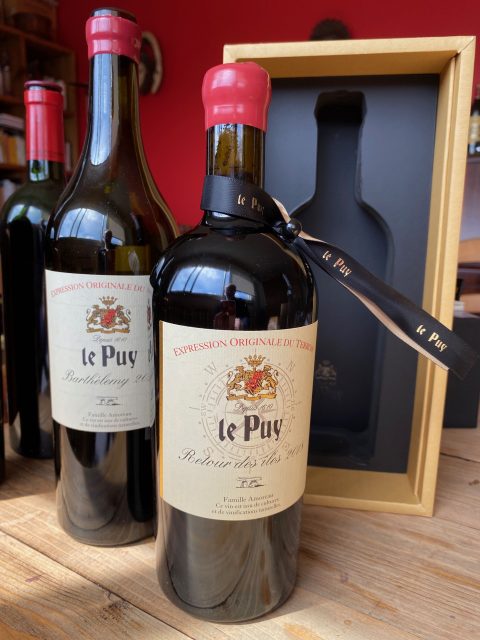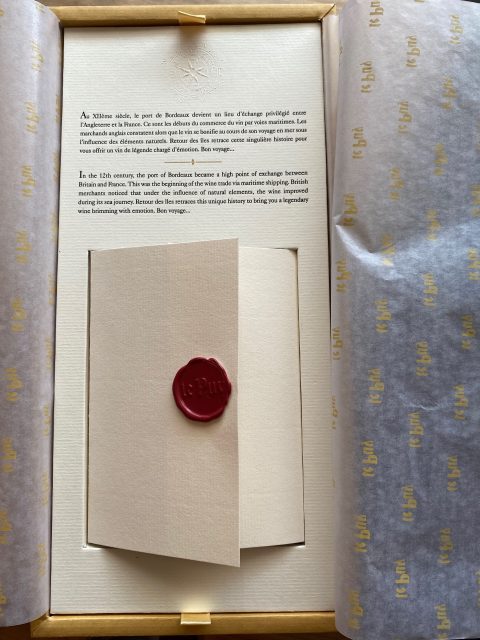This website uses cookies so that we can provide you with the best user experience possible. Cookie information is stored in your browser and performs functions such as recognising you when you return to our website and helping our team to understand which sections of the website you find most interesting and useful.
Worth the trip? Chateau Le Puy’s well-travelled cuvée Retour des Îles
In the fine wine world – in which provenance is king – it is perhaps difficult to imagine that a wine that has travelled 20,000 kilometres might be seen to have benefited from the trip.

And, of all people, I should know this better than most. For, a long time ago, well before I wrote for The Drinks Business, I purchased a case of Chateau Mouton Rothschild 1970 at auction for what I still like to think to be the lowest ever auction price paid for the wine. My hand-written note suggests a hammer price of £260 for a full case (duty paid).
But, as you’ve probably guessed already, there was a catch. As the catalogue made clear, the wine sported Argentinian slip labels. It had travelled, in other words, roughly 20,000 kilometres before the hammer fell. Lovely though it was (none remains), it hadn’t benefitted from the trip.
There are other rather more famous examples too. Without being too cynical, the rather costly exercise of aging Chateau Petrus 2000 for 14 months in the International Space Station seemingly confirmed little more than the hunch that bad storage doesn’t improve the taste of a wine in bottle. Though the same cannot be said for its estimated value.
But in general it seems odd to charge a premium for a wine with a passport and, if not quite air miles, then certainly sea legs. But that is what we have here, with Chateau Le Puy’s fascinating micro-cuvée Retour des îles.
Given my form with wines that have travelled, I was not going to refuse the invitation to taste this uniquely itinerant bottle and, indeed, to compare it directly with the same vintage of the cuvée Barthélémy from which the travelling barrels were selected.
We’ll come to the tasting presently. But first it is important to say something about the pedigree of this wine. It comes, of course, from Chateau Le Puy, perched high above the Dorgogne at Saint-Cibard on the famous Coteau des Merveilles, overlooking Pomerol on the continuation of the fossil-rich limestone plateau of St Emilion itself. At an altitude of 107 metres, the vineyard is the highest in the Bordeaux region with Le Puy itself roughly translating as ‘high place’, ‘summit’ or ‘mountain peak’.
The property has been in the hands of 15 consecutive generations of the Amoreau family, since 1610 and is farmed entirely organically and biodynamically.
The idea behind the wine comes from Jean-Pierre Amoreau’s reading of an article on the Hundred Year’s War. This (the war, not the article!) disrupted the sea passage between Bordeaux and England with the effect that, from this moment on, wine destined for England would cross the Channel in northern France rather than be conveyed directly by boat from Bordeaux to London. What interested Jean-Pierre Amoreau most was the observation that the English noted a deterioration in the wine they received and, above all, that they attributed this to the more circuitous route it now took largely by road.
Inspired by this and by his own passion for sailing, he sought to conduct an interesting kind of experiment – consigning a carefully selected four barrels of his micro-cuvée Barthélémy to a 20,000 kilometre (and 8-10 month) return trip via the Caribbean on a brigantine sail boat powered only by the winds of the Atlantic. The experiment continues, with the most recent release being the 2018 that I tasted.
Having been carefully stowed aboard, the barrels leave the port of La Rochelle for, respectively, Barbados, Boca Chica in the Dominican Republic, Santa Marta, Puerto Cabezas and Puerto Cortes before returning to La Rochelle and thence to the cellars of Le Puy via Chetumal in Mexico. The details are nicely described in a short youtube video (in French, but with English sub-titles).
The tasting

So now we come to the all-important question: does a 20,000 kilometre wind-powered round-trip bring something – anything – to the wine? And, if so, what?
Put in such terms, the question is actually very difficult to answer. For there is more than one variable at work here. But there are a few things that we can be absolutely clear about from the start.
First, both of these wines – Barthélémy 2018 and Retour des Îles 2018 – are really excellent and are both wonderfully expressive of their impressive and distinct terroir. Second, although they each express that terroir very well, they do so very differently. These are far from being identikit versions of one another – no one contemplating purchasing either bottling should be in any doubt about that. And, third, crucially, the Retour de Îles is unequivocally the better wine in my view.
Just to be clear, my agreement with the property is that I would not score these wines (since Chateau Le Puy does not participate in competitive tastings – a view I very much respect). But, were I to have done so, Retour des Îles would have received the higher score of the two (and both would have received impressive scores quite consistent with their elevated price point).
So doesn’t all of this imply that a retour des îles (a journey to the islands and back) is a good thing – and that more wines might ultimately benefit from this or something vaguely equivalent?
Well, not necessarily. There are at least two issues here that need careful unpacking.
The first is the need to differentiate between the respective roles played by the selection of the barrels on the one hand and their long-distance sail-powered élevage on the other. The second is, if you like, a question of format – the (important) fact that the wine’s travel took place in barrel during its élevage rather than in bottle after it had been completed.
Let’s consider each in turn. Whilst it is very credible to think that the unusual condition of élevage here made a very significant difference to the taste and texture of the wine – for reasons we’ll come to in a second – it is certainly no less credible to think that the lion’s share of the qualitative difference between these two wines comes simply from the selection of the barriques themselves. Without having tasted from the barrels before their journey it is impossible to know. But what is interesting is that the itinerant bottling does seem to have been influenced by its passage at sea – most obviously, in that it seems to have acquired a subtle marine, iodine note that I tend to associate with the wines of the tip of the Médoc, close to the Atlantic (most obviously Pagodes de Cos blanc). The sensation of sea-spray also serves both to accentuate the natural minerality of the terroir and to reduce the more sweet spicy notes that come from the barrique itself (and that are more obvious in the Barthélémy cuvée).
But there is also a significant textural difference between these wines, with the Retour des îles significantly more voluptuous, fuller and more harmonious, above all in the mid-palate; its tannins too seem more fine-grained and more silkily textured; and it is longer on the finish and more chiselled and crystalline. All of this, I suspect, comes from a combination – an interaction – between the quality of the wine in the barrel and the unusual aging process. One discerns perhaps the influence of the rhythmic movement of the swell on the wine in the barrel.
Second, the format is crucial here. It is, for me, much more credible to think that a wine during its élevage and in barrel might benefit from a trip to the islands and back, than it is to think that a bottle of Petrus might benefit from a trip to the stars and back.
In any effect, a certain magic has been performed – which, though it doesn’t entirely surprise me, I still find extraordinary. Wine is a constant form of experimentation; and this experiment seems to have performed a certain kind of alchemy.
Let me conclude by drawing a slightly mischievous implication from all of this. Next time Chateau Petrus thinks of sending its wine to space, rather than consigning just a few bottles, it should perhaps consider sending an entire barrel during élevage! Needless to say, I for one would happily report on that tasting.
The wines tasted
Chateau Le Puy Cuvée Barthélémy 2018 (85% Merlot; 15% Cabernet Sauvignon; 13.9% alcohol; pH 3.39; from ‘les rocs’, a parcel of around 3 hectares). Retail price: €117 per bottle. Around 15,000 bottles produced.
Chateau Le Puy Retour des îles 2018 (85% Merlot; 15% Cabernet Sauvignon; 14.3% alcohol; pH 3.42; from 4 barrels for the Cuvée Barthélémy). Retail price: €325 per bottle (individually numbered and presented in a special collector box). Around 1,200 bottles produced.

